- WARNO: Return of the real-time tactics king
Unless something extraordinary comes out in the next few months, I already know what my Game of the Year for 2024 will be: Eugen Systems’ WARNO.
WARNO is a real-time tactics game, set in an alternate 1989 where the Cold War escalated into World War 3. Building on Eugen’s earlier Wargame and Steel Division series (for which long-time readers will know my love), it offers:
- Individual battles, with a choice of over a dozen playable divisions (rising to 20+ with DLC);
- Scripted battles;
- Five campaigns, each combining a turn-based strategic layer with tactical battles; and
- Both single- and multiplayer modes for battles and campaigns.
The result is a game that’s deep, rich in content, and tremendously replayable.
Tactical battles are superb
WARNO’s battles and the supporting army customisation system are the culmination of lessons learned from Wargame and Steel Division. They offer a rich experience that reward combined arms, create fluid, back-and-forth battles, and encourage replayability.
In battle, the goal is to seize and control objectives, each worth a certain number of points over time1. Achieving this requires coordinating tanks, infantry, scouts, artillery, helicopters, fixed-wing aircraft, ground-based air defences, supply units, and more. Over the course of a match, reversals are common and early leads can slip away, as players call in reinforcements, strengthen their defences, and identify and breach enemy weak points.
Playing well requires both attention to detail and an ability to keep an eye on the bigger picture. For example:
- I carefully micromanage high-end tanks so that if I see incoming anti-tank missiles, I can quickly order the tanks to conceal themselves with smoke and retreat.
- One lesson the computer taught me very, very early on was the importance of moving artillery after firing, because it’s quick (probably even quicker than humans) to respond with counterbattery fire.
- At the same time, it’s important not to fixate too much on one part of the map. The maps are very large, and threats (or targets) may emerge elsewhere.
- By keeping my eyes open in team games, I’ve seen plenty of opportunities to help other players capture objectives and shore up defensive lines.
It helps that WARNO has quality of life features such as a line of sight/unit range checker, eliminating “can I hit that target from here?” guesswork.

How does a WARNO battle play out in practice? Imagine the following example:
- The match begins with a race for the objectives, led by recon units, forward-deployed airborne troops, and heliborne air assault infantry. Soon afterwards, the first wave of tanks rumbles in.
- The winners of the initial clash consolidate their positions, while the losers pull back, lick their wounds, and set up new defensive positions further back.
- The lines harden, and players bring in more artillery and air defences while saving up for a big push.
- Eventually, one side or the other will launch that push. Sometimes, it breaks through and wins the match. Sometimes it doesn’t. And sometimes, it breaks through, but not fast or far enough to turn the game around.
- Win or lose, once the match is over, it’s time to reflect on lessons learned, tweak my army composition, or perhaps try a different division next time — on which more below.
The disclaimer I should add is that I seldom play single-player skirmish games — instead, I normally play multiplayer. By now, I can reliably trounce the AI on “Hard”, the highest difficulty setting on which it doesn’t get a resource bonus. It does particularly badly at attacking urban areas, with a tendency to blunder tanks into ambushes.
In general, I think the AI is the main limiting factor for WARNO — discussed further in the campaign section, below. The good news is that the developers read and respond to AI feedback, so over time this may improve.
Multiplayer: a test of skill (1 v 1), and a gloriously messy spectacle (10 v 10)
Multiplayer is effectively several different games in one, depending on how many players are in a match: 1 v 1 matches play very differently from my mainstay, 10 v 10.
1 v 1 games are about pure skill. Everything I said about tactics above applies; and victory & defeat are up to me. Don’t ask what my win/loss record is…
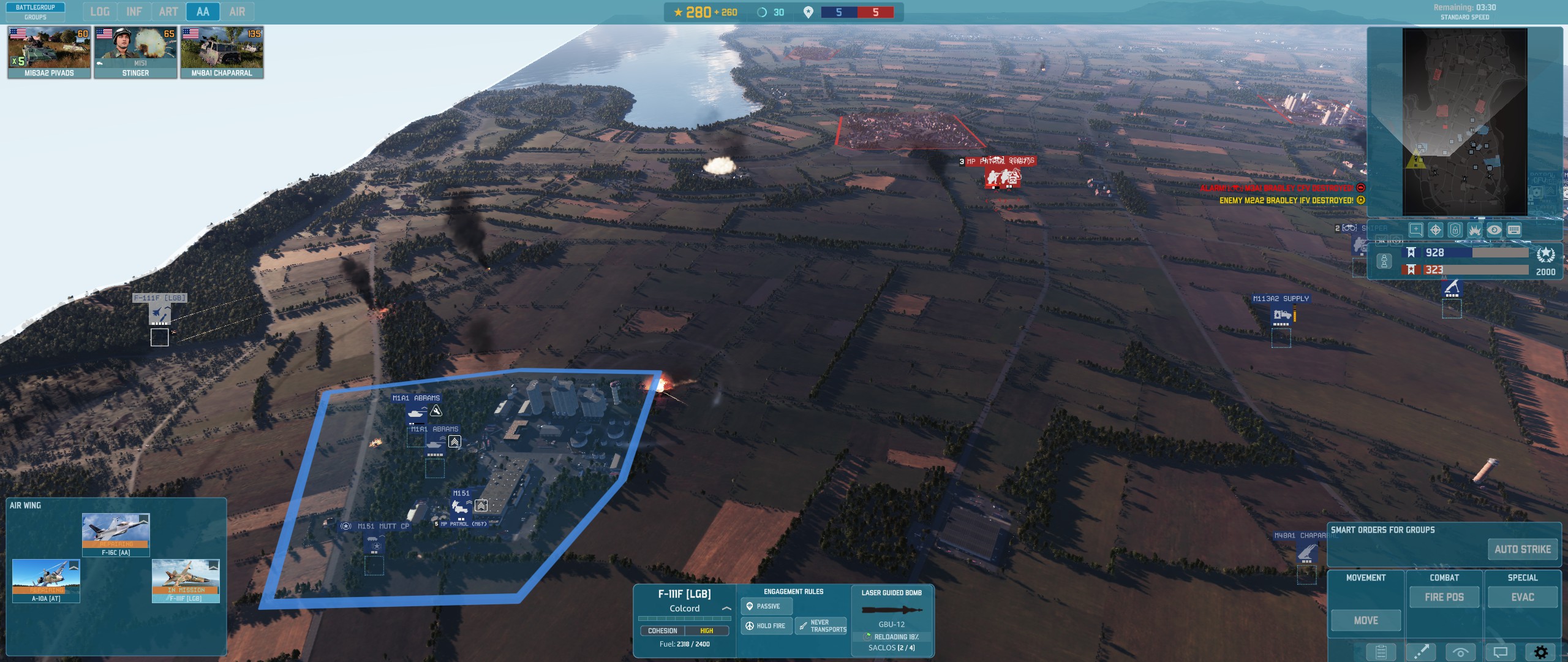
At the opposite extreme, 10 v 10 games offer spectacle — and plenty of chaos:
- Player (and unit) density are high:
- Visually, this looks cool, as convoys set out across roads, massed aircraft soar overhead, rocket barrages tear up the ground, and teams mass for their “big push”.
- In terms of gameplay, this is a large change. Denser air defences make aircraft more difficult to use, and massed artillery makes it harder to keep infantry alive in fixed, exposed positions.
- Players can focus on a smaller part of the map, instead of being responsible for everything.
- While the public nature of 10 v 10 lobbies limits player coordination, when teams do work together by luck or design, they are impressive: I recently played against a first wave of air assault infantry that screened a second wave of tanks, while rocket artillery pounded my attempts to concentrate in a nearby treeline.
- The flip side is that 10 v 10 games can be decided by silly mistakes2 or players who drop out and leave bots to take their place. I take a philosophical view and treat these matches like Mario Kart. Having fun is the most important thing!

Customising armies adds to replayability
Interacting with skirmish mode is the army customisation system. Between battles, players build their deck — the available forces — from one of the available divisions, each of which has its own strengths, weaknesses, and play style. Different division types from the same country can play very differently to each other. For example:
- Airborne divisions can quickly reach objectives thanks to their paratroopers’ ability to deploy forward at the start of a match. But they lack heavy units, which limits their ability to fight in open terrain or go head-to-head against better-armed divisions as the match goes on.
- At the opposite extreme, armoured divisions typically peak later in the match, once they bring in a critical mass of tanks. They do best in open areas, where their modern tanks can take advantage of long engagement ranges, and worst in cities and forests, where infantry can ambush them at close quarters.
- Other division types include:
- Mechanised infantry divisions, WARNO’s jacks-of-all-trades.
- Air assault divisions, featuring helicopters and heliborne units.
- Reservist divisions, with older kit and second-line troops.
- These classifications aren’t absolute: the UK 1st Armoured Division includes forward-deployed paras, and the UK 2nd Infantry Division is a mechanised/air assault hybrid.
This contributes to both faction diversity and replayability, as there is a lot of scope to try different divisions and tactics. The same map can play very differently depending on the chosen division.
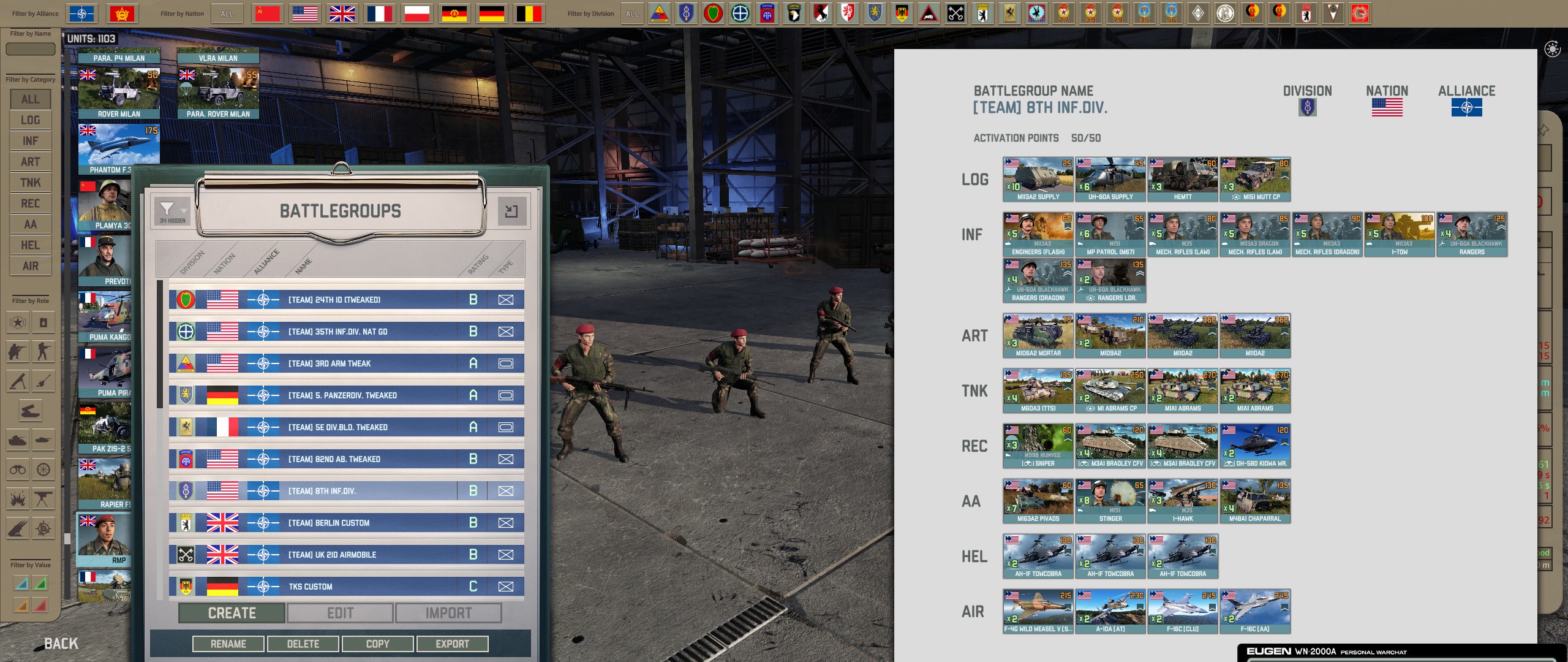
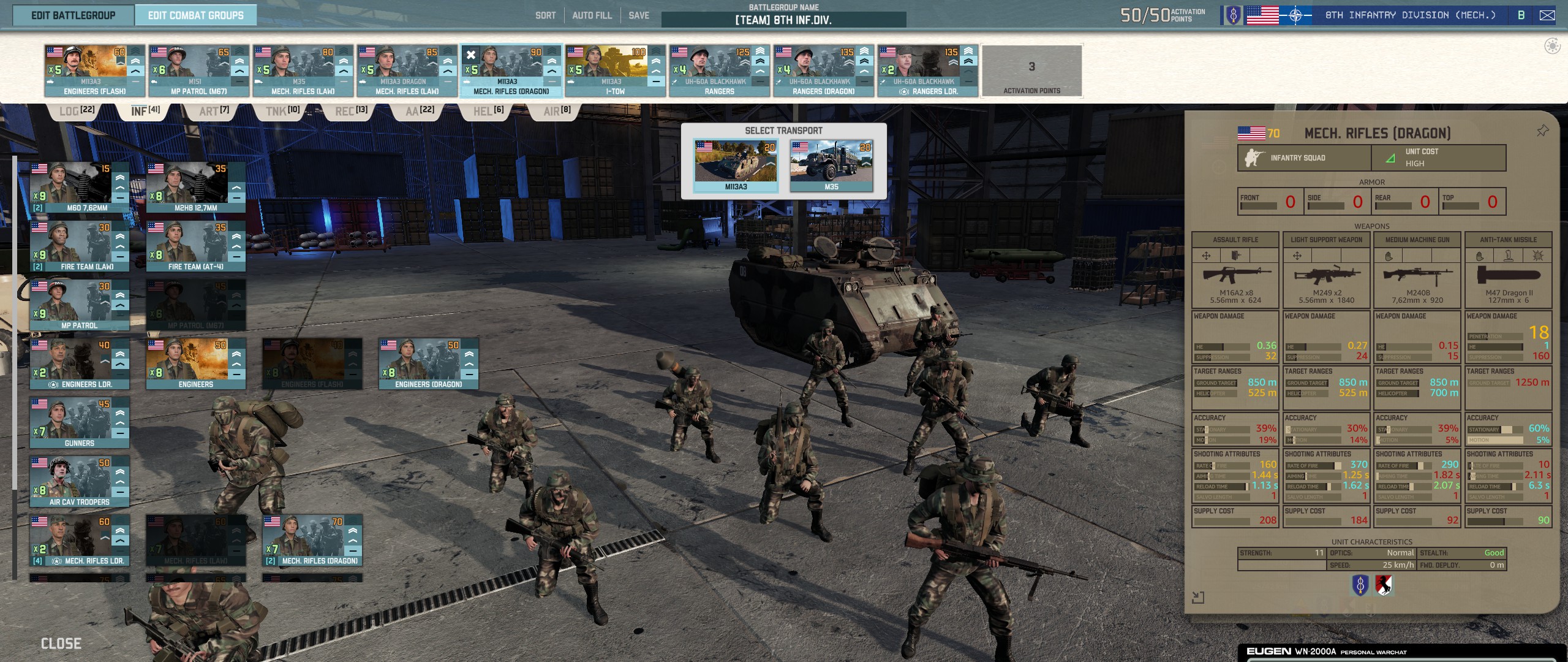
Scripted operations add flavour
Besides the regular skirmish battles described above, WARNO includes eight “operations”. These are scripted single-player battles with set maps and unit rosters, comparable to the historical battles in Total War games. They’re not my favourite mode:
- AI limitations make defensive operations too easy.
- Like Total War, I think WARNO works better in the more freeform environment of skirmish3.
However, I enjoy their chrome (voice acting, introductory briefings, and events), and a certain operation has possibly the best twist I can remember in an RTS mission. I’ll leave you to discover which one…
Campaigns are intricate and satisfying, although tactical AI has room to improve
WARNO offers five “Army General” campaigns (one introductory and four main ones), of which I have beaten the first three. The campaigns offer an engaging strategic layer and can generate memorable tactical battles, although eventually I turned to auto-resolve.
The campaign strategic layer is a simple turn-based wargame in its own right, representing individual units down to the battalion level. Units can attack enemies next to their zone of control; nearby units (and support units such as artillery and aircraft) can join in. The player can fight the resulting battle on the tactical map, or auto-resolve. Battles progressively wear down units through fatigue and casualties; fatigue can be recovered, but men and equipment cannot.
For players familiar with the dynamic campaigns in Wargame: AirLand Battle and Wargame: Red Dragon, the WARNO campaigns will feel like moving from the 2D to the 3D Total War games: the map and the front lines are much more detailed than the large, aggregated provinces in the old games.
Even by itself, the strategic level of the campaign offers an interesting challenge — I confirmed this by playing the “Airborne Assault” campaign using mostly auto-resolve. There is an art to:
- Judging what’s needed to take or hold an objective (and allocating forces accordingly);
- Positioning units for mutual support;
- Cycling fatigued or depleted units off the front line;
- Assessing where and when to fall back versus holding on or pushing; and
- Allocating scarce supporting units to achieve the best effect.
Armoured battalions were my workhorses. I liked to use helicopter squadrons to hunt down the most threatening Soviet units, typically the ones with the newest tanks. Meanwhile, I learned to keep infantry battalions in urban tiles so they’d have favourable terrain on the tactical map.
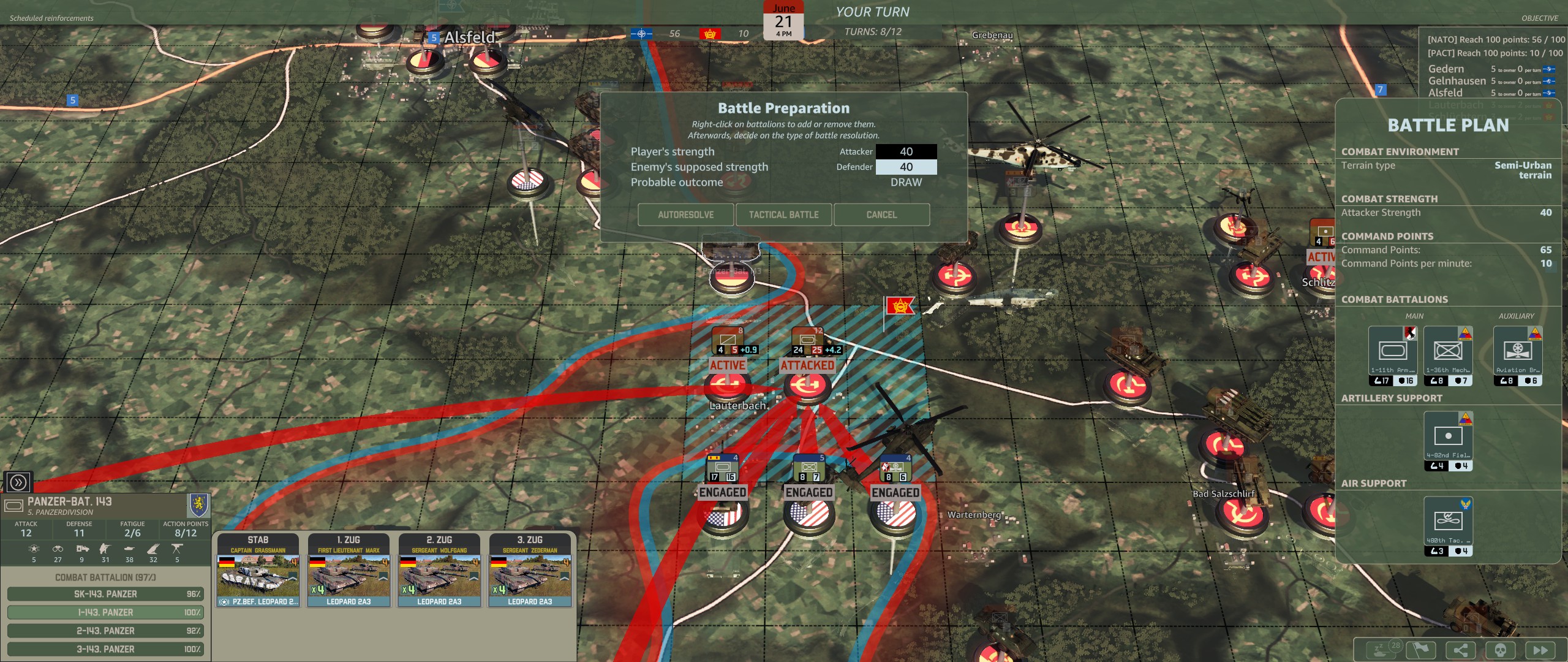
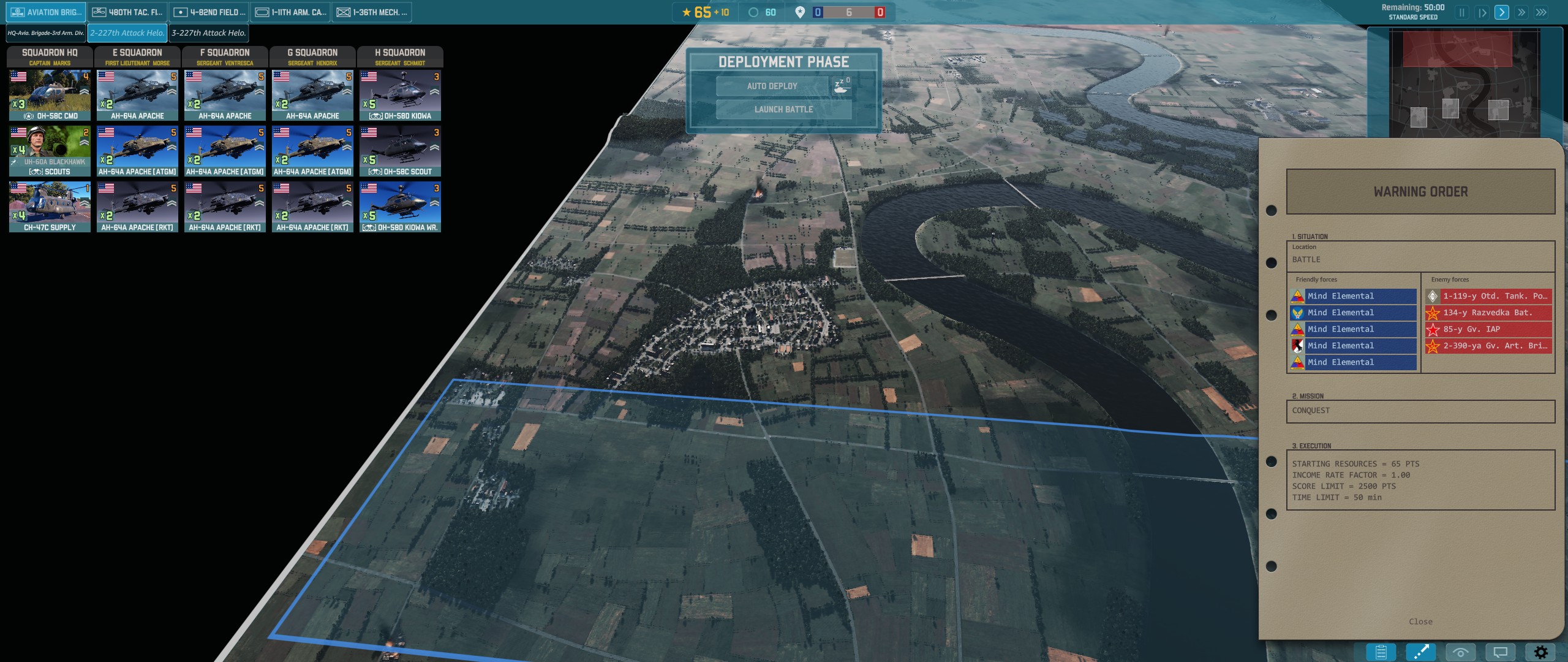
Aiding this, WARNO’s strategic AI is surprisingly good:
- It attacks objectives with overwhelming force, and tries to bypass or cut off isolated defenders along the way.
- It redeploys as needed, pulling back mangled units to safety, and withdrawing vulnerable support units if I punch through the front line.
- When on the defensive, it waits for me to overstretch myself and then hits back hard, taking advantage of my attacking force’s fatigue.
Its main weakness is that when I attack on my turn, the AI seems too prone to hanging the target unit out to dry instead of sending in reinforcements.
Playing out battles on the tactical map gave me some memorable moments:
- My proudest victory was holding out with a handful of combat engineers and the infantry accompanying an air defence unit against a Soviet armoured assault. Fortunately the map was dominated by two cities, where I holed up in terrain that was extremely favourable to me, allowing my soldiers to ambush and rocket the Soviet tanks.
- At the other extreme was a cathartic battle when I caught up with an enemy artillery unit on the strategic map, giving my rampaging tank crews the chance to take revenge for all the barrages they suffered.
- And I once led a scratch force of West German light infantry and home guardsmen, supported by mortars and strafing runs by US F-16s, to victory over elite Soviet and East German special forces4.
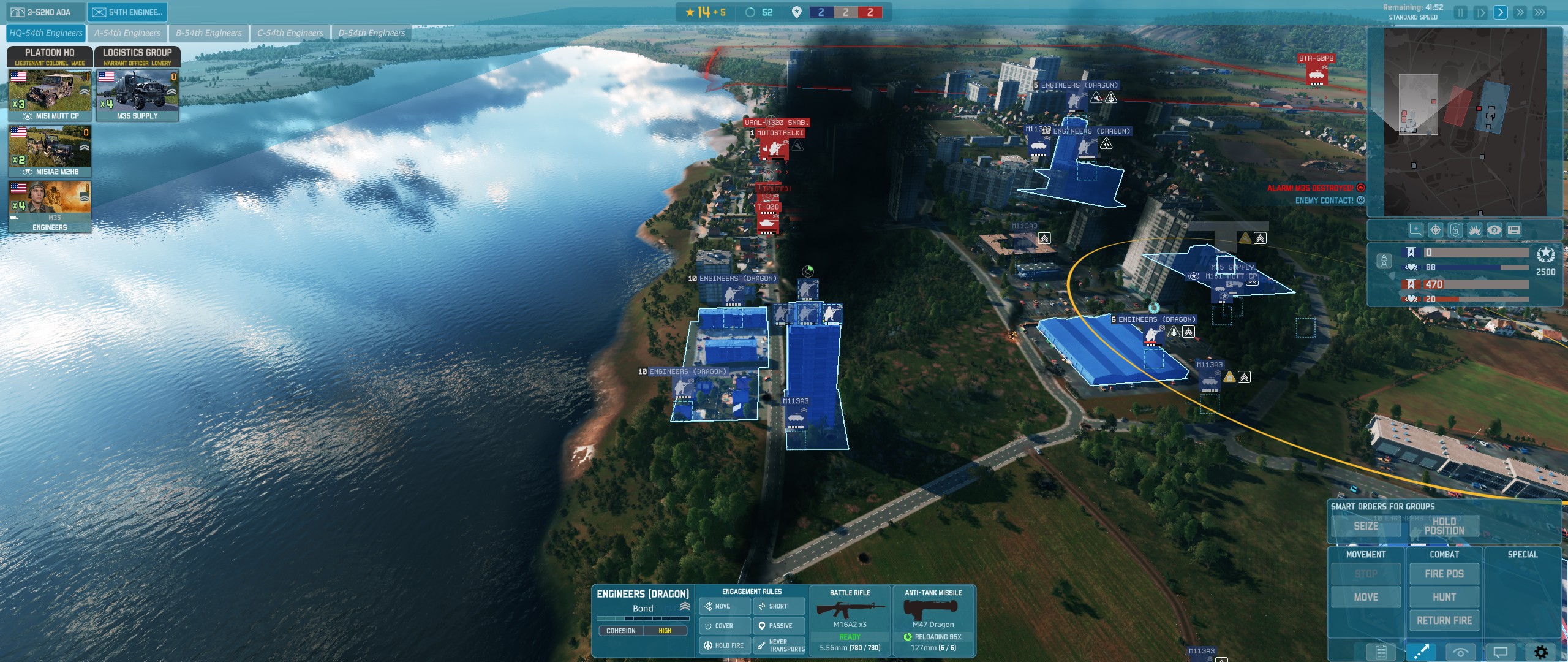
Along the way, I also played out many, many bread-and-butter tank battles:
- Sometimes it was a clash of the titans: modern US and West German tanks against their Soviet counterparts.
- Sometimes I had mechanised infantry supporting my tanks.
- Sometimes I just had the mechanised infantry, supported by modern anti-tank missiles — of which I always wanted more.
- Sometimes I had outdated tanks, but helicopters or airpower let me even the odds.
They were often challenging and exciting, especially when I was outmatched (such as in the opening battles of the “Fulda Gap” campaign — more below) or had to think outside the box. Over the length of several campaigns, they eventually became repetitive, which was what prompted me to auto-resolve most of “Airborne Assault”.
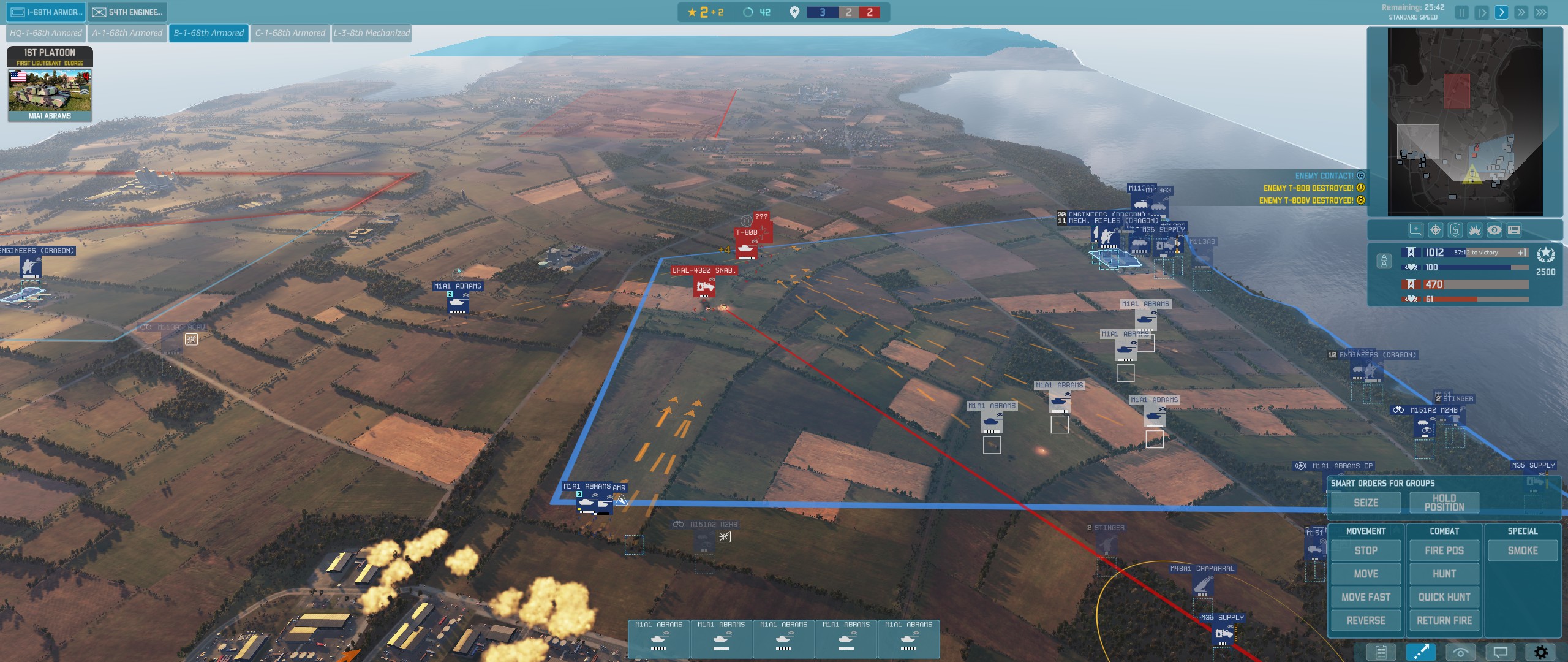
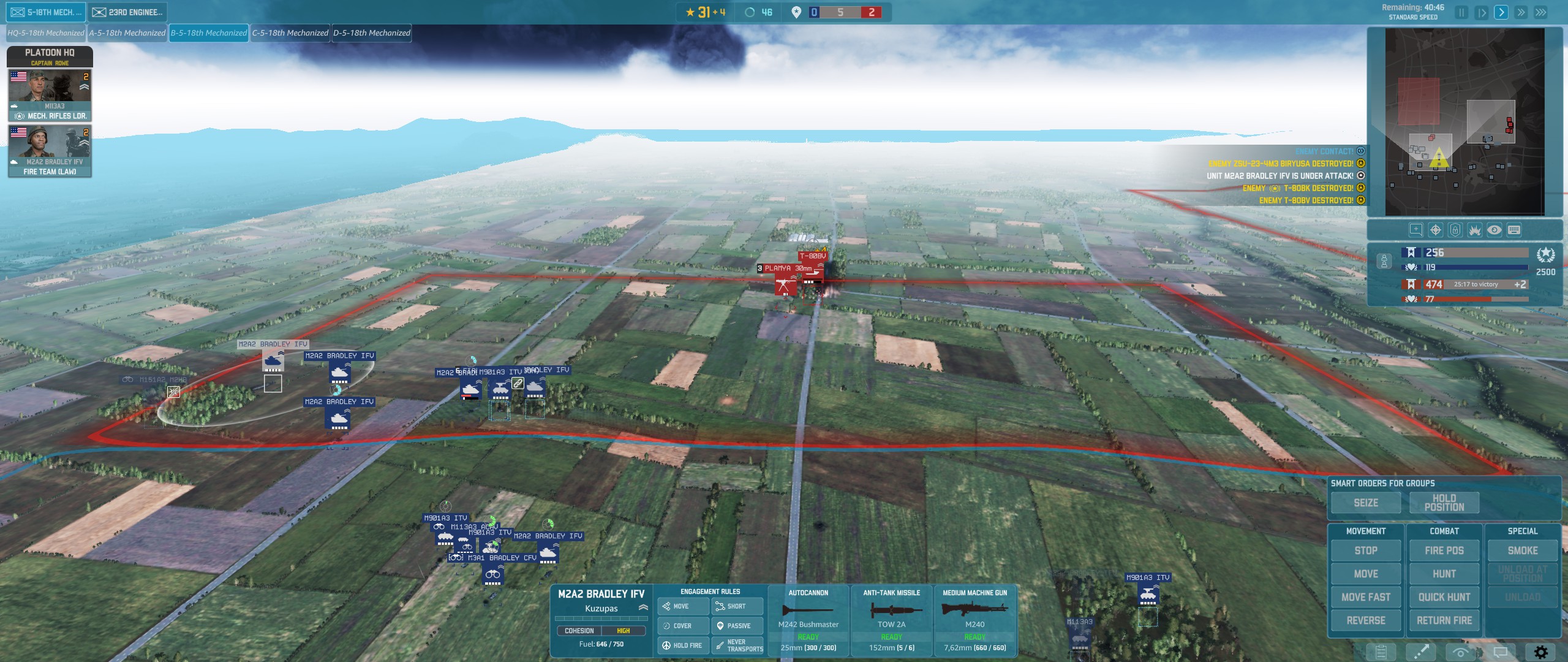
The campaigns’ biggest limitation is the tactical AI, which opens nearly every battle by charging a massed tank column down the highway. Their sheer mass can be dangerous, especially if I’ve spread out too thinly in my opening deployment. But this also presents several problems:
- It’s predictable: I know I need to deploy to stop the opening tank rush. This leaves the computer open to counters, particularly airpower.
- It’s often not the best choice: the computer relies on tanks even in terrain that would be better suited to infantry, such as the urban map on which I holed up with my engineers.
- It makes the tactical battles more repetitive: there are only so many times I want to fight a T-80 rush.
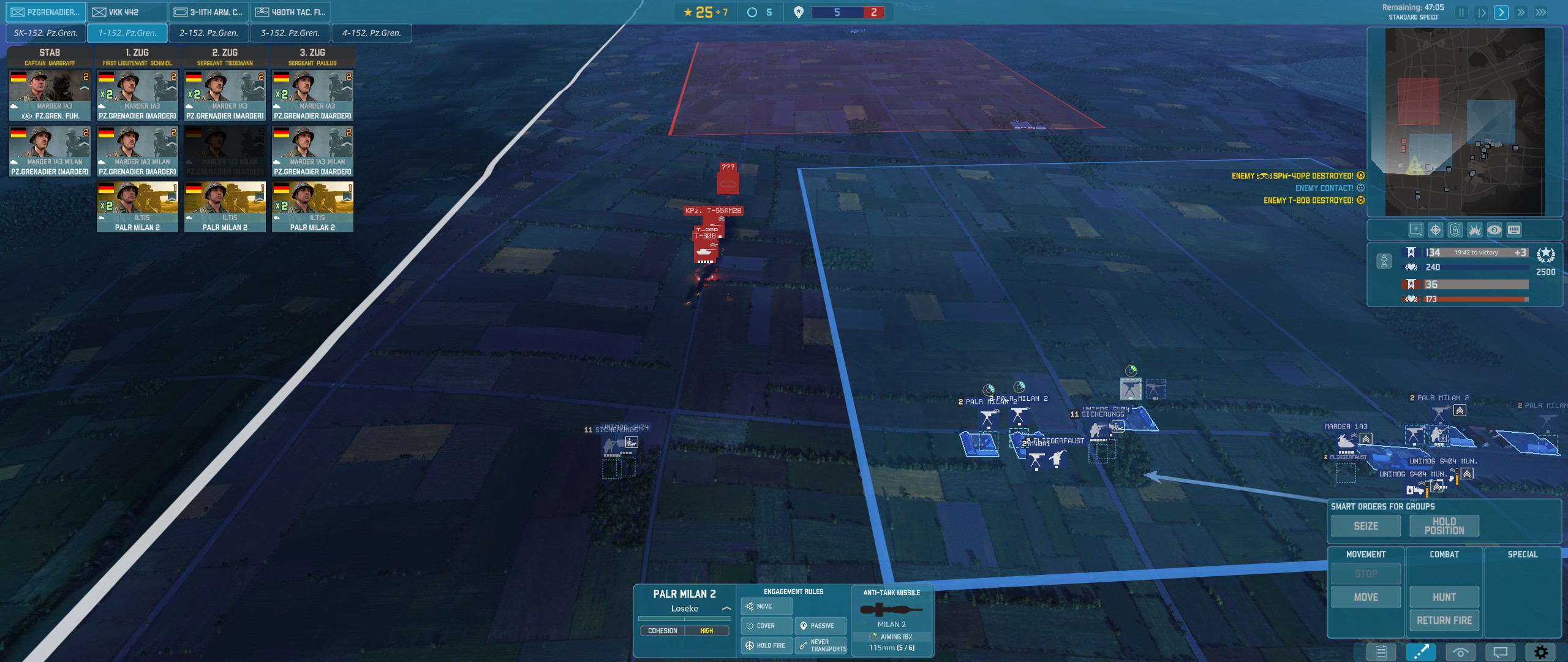
What’s in each campaign?
The introductory campaign, “Bruderkrieg”, and the first main campaign, “Fulda Gap”, both begin with the opening shots of the war, as East German and Soviet forces surge across the border. The US 11th Armored Cavalry Regiment must survive the onslaught and stage a fighting retreat until West German and US reinforcements arrive to hold the line. The opening battles are epic, in the sense of “the defence of a narrow place against the odds”; the outnumbered but heavily armed 11th ACR can maul its pursuers. Once reinforcements arrive, the focus shifts to holding — and recapturing — the objectives. “Bruderkrieg” covers a smaller section of this battle, while “Fulda Gap” covers a wider area.
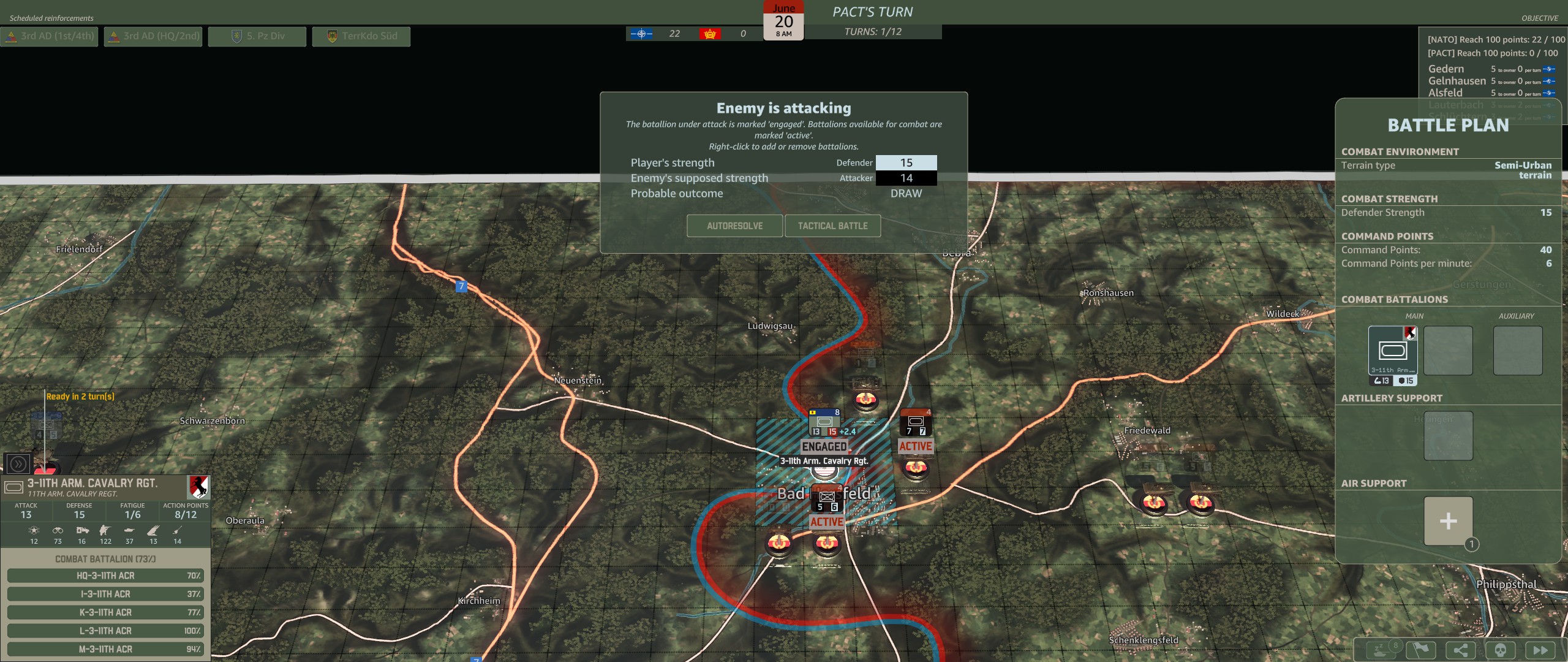

“Airborne Assault” is also set during the outbreak of war, further to the north. After Soviet and East German commandos seize an airport behind the lines, the West German army must quickly take back the airport before Soviet reinforcements fly in, then shift its attention to the oncoming Soviet tank columns. The West Germans in this campaign have older equipment than those in “Fulda Gap” and rely more on lightly armed infantry and home guard units, offset by generous German, US, British, and Belgian air support.
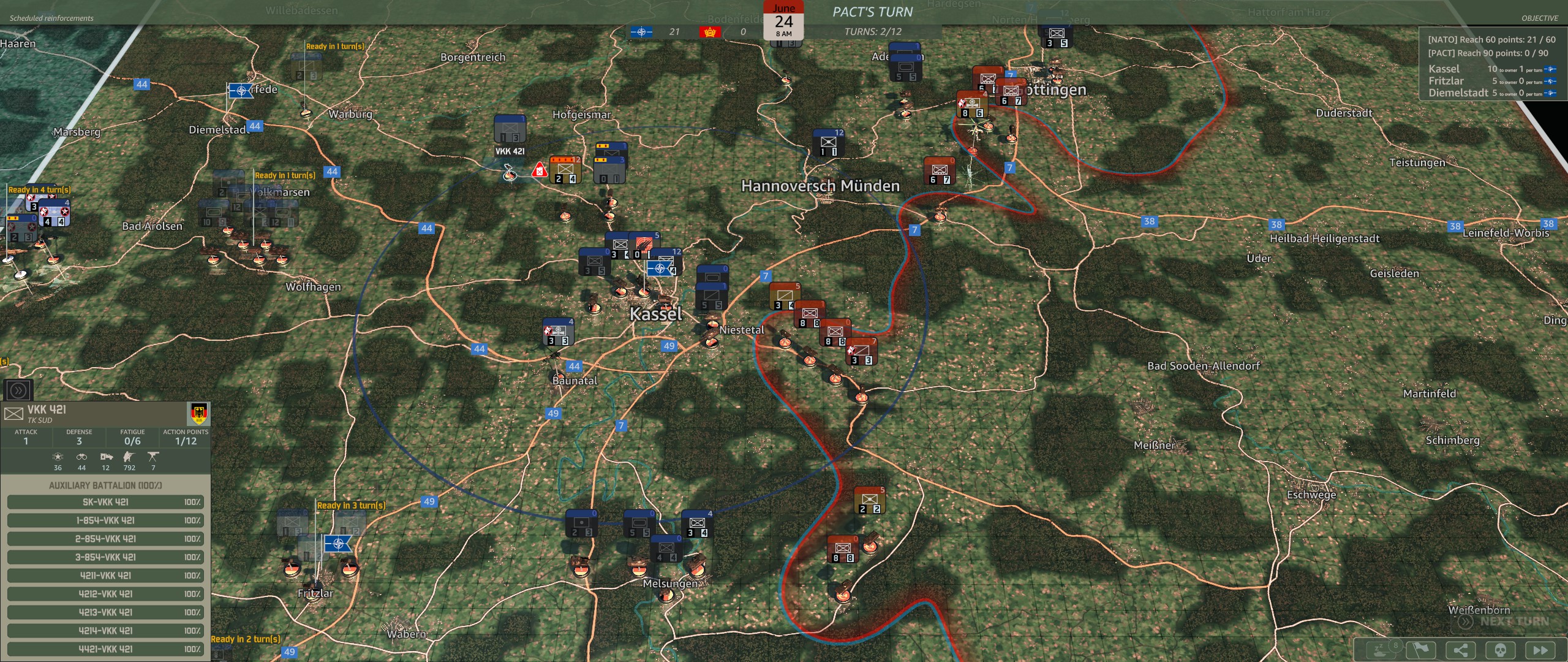
I have yet to play the last two campaigns, “The Left Hook” and “Highway 66”. Both take place several days into the war: both sides begin depleted after the initial Soviet offensives, while NATO is preparing to counterattack once reinforcements arrive: Belgians5 and British in “The Left Hook”, and the US 1st Armoured Division in “Highway 66”.
Following the recent release of a new patch, it’s a good time to start on “The Left Hook”. After that, we’ll see how much appetite I still have — “Highway 66” is a monster of a campaign, the only one marked as “very long”.
The roadmap has plenty for both skirmish/multiplayer and campaign players
WARNO has several DLC available as of September 2024, plus a roadmap that runs out to 2025:
- The Early Access Pack adds 7 new divisions for skirmish and multiplayer. These are more “exotic” than the base game divisions — for instance, NATO receives the Berlin Command, a multinational force with exclusive access to the F-117 but almost no modern fighter aircraft or (until the latest patch) long-ranged air defences.
- Smaller “Nemesis” DLCs add 2 new divisions each (1 NATO and 1 Warsaw Pact). The first one is already out, adding the US 101st Airborne and the Soviet 56th Air Assault divisions.
- Larger expansions will add new fronts in the war, new divisions, and more campaigns. So far, Eugen has announced two: NORTHAG and SOUTHAG.
- The Gold Edition includes these two expansions and the first two Nemesis DLCs. It doesn’t include the Early Access pack.
As an Early Access customer and owner of the Gold Edition, I have all the currently released DLCs. I like them and would recommend them to any fans — the trade-off between cool, unique toys and often serious limitations makes the DLC divisions fun and interesting to play. At the same time, none are essential.
Conclusions
WARNO is a worthy heir to some of my favourite games of the last decade. It is not perfect, notably in its tactical AI. All the same, it has entertained me for over 130 hours, across both single-player and multiplayer modes, and through individual battles and campaigns, since I started playing late in its Early Access period. If you are interested in its genre (real-time tactics) and its period, I cannot recommend it highly enough.
- This is the default “Conquest” mode. There is an alternate mode, “Destruction”, where the goal is destroying enemy units instead. ↩
- The classic is when one player has to hold a section of the map against multiple players from the enemy team. ↩
- Similarly, I prefer Eugen’s dynamic campaigns to its scripted campaigns. ↩
- Taking on Soviet elites with NATO reservists seems to be my habit in Eugen campaigns — I did something similar back in Wargame: AirLand Battle ↩
- Currently, the Belgians are campaign-only. Belgian divisions will become playable in skirmish and multiplayer in the “NORTHAG” expansion. ↩
Discover more from Matchsticks for my Eyes
Subscribe to get the latest posts sent to your email.